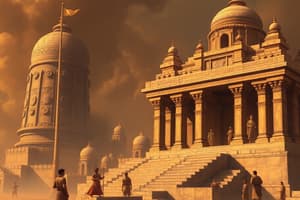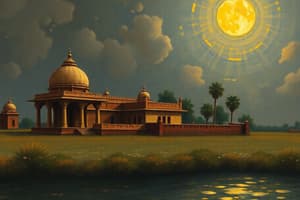Podcast
Questions and Answers
Where was the Harappan Civilization discovered?
Where was the Harappan Civilization discovered?
- In present-day Afghanistan
- In present-day Iraq
- In the Indus Valley region (correct)
- In southern India
What was the purpose of the seals used by the Harappan Civilization?
What was the purpose of the seals used by the Harappan Civilization?
- For religious rituals only
- For decorative purposes only
- For administrative and trade purposes (correct)
- For building construction
What was unique about the city of Lothal?
What was unique about the city of Lothal?
- Its grid layout
- Its sophisticated water management system
- Its unique fire altars
- Its dockyard (correct)
What is suggested by the existence of citadels in Harappan cities?
What is suggested by the existence of citadels in Harappan cities?
What is believed to be a possible cause of the decline of the Harappan Civilization?
What is believed to be a possible cause of the decline of the Harappan Civilization?
What was unique about the streets of the Harappan Civilization?
What was unique about the streets of the Harappan Civilization?
What was the main feature of the drainage system in the Harappan Civilization?
What was the main feature of the drainage system in the Harappan Civilization?
What was the basis of the economy of the Harappan Civilization?
What was the basis of the economy of the Harappan Civilization?
What was a unique feature of the houses in the Harappan Civilization?
What was a unique feature of the houses in the Harappan Civilization?
What was a characteristic of the metal work in the Harappan Civilization?
What was a characteristic of the metal work in the Harappan Civilization?
Flashcards are hidden until you start studying
Study Notes
Discovery of the Harappan Civilization
- Discovered in the 1920s during excavations in the Indus Valley region by archaeologists like John Marshall and Rakhal Das Banerjee.
- Extensive trade with Mesopotamia (present-day Iraq) evidenced by seals and artifacts.
Important Sites of the Harappan Civilization
- Mohenjo-daro: Located in present-day Pakistan, one of the largest and most well-known Harappan cities.
- Harappa: In Pakistan, gave its name to the civilization.
- Lothal: In Gujarat, known for its dockyard.
- Kalibangan: In Rajasthan, known for its unique fire altars.
- Dholavira: In Gujarat, known for its sophisticated water management system.
Society
- Urban Society: Cities were centers of trade, craft, and administration.
- Social Hierarchies: Possibly stratified society based on occupation.
Religious Practices
- Seals and Figurines: Depictions of possibly deities and rituals.
- Fire Altars: Found in some sites, suggesting fire worship.
Features of the Harappan Civilization
- Centralized Authority: Evidenced by citadel structures in major cities.
- Administration: Seals used for administrative purposes, possibly indicating a ruling elite.
Town Planning
- Grid Layout: Cities were planned on a grid pattern with streets crossing at right angles.
- Citadels: Higher area within the city, likely used for administrative and religious purposes.
Harappan Streets
- Well-planned: Laid out in a grid pattern, with some streets as wide as 30 feet.
- Drainage: Each house had access to a covered drainage system that emptied into main drains below the streets.
Economy of the Harappan Civilization
- Agriculture: Based on wheat, barley, and domesticated animals.
- Crafts and Industries: Skilled craftsmen in pottery, metallurgy, and bead-making.
- Metal Work: Copper and bronze artifacts found, indicating advanced metallurgical skills.
Houses
- Brick Construction: Houses were made of baked bricks.
- Standardized Layout: Typically had a courtyard surrounded by rooms.
Unique Features of the Harappan Civilization
- Harappan Script: Yet to be fully deciphered, found on seals and tablets.
- Measurement System: Standardized weights and measures.
- Art and Craft: Terracotta figurines, pottery with distinct designs.
Drainage System
- Advanced: Covered drains made of bricks, designed to carry wastewater away from residential areas.
- Sanitation: Indicates concern for hygiene and public health.
Decline of the Harappan Civilization
- Possible Causes: Natural disasters like floods, changes in river courses, and ecological degradation.
- Aryan Migration: Some scholars suggest migration of Aryans as a factor.
Studying That Suits You
Use AI to generate personalized quizzes and flashcards to suit your learning preferences.




